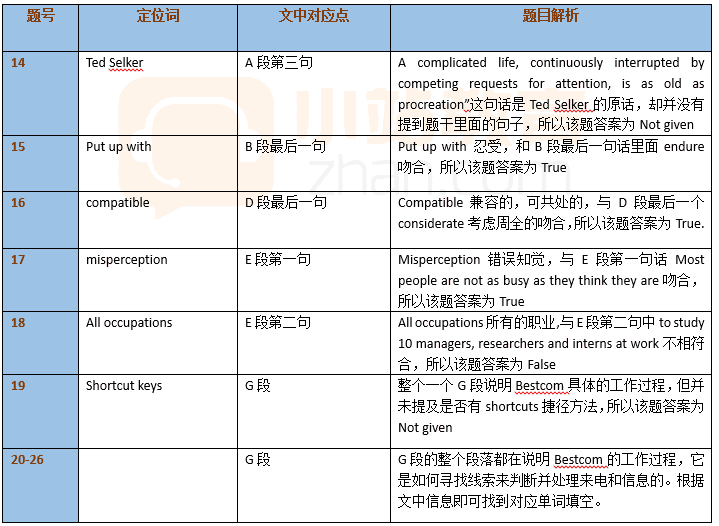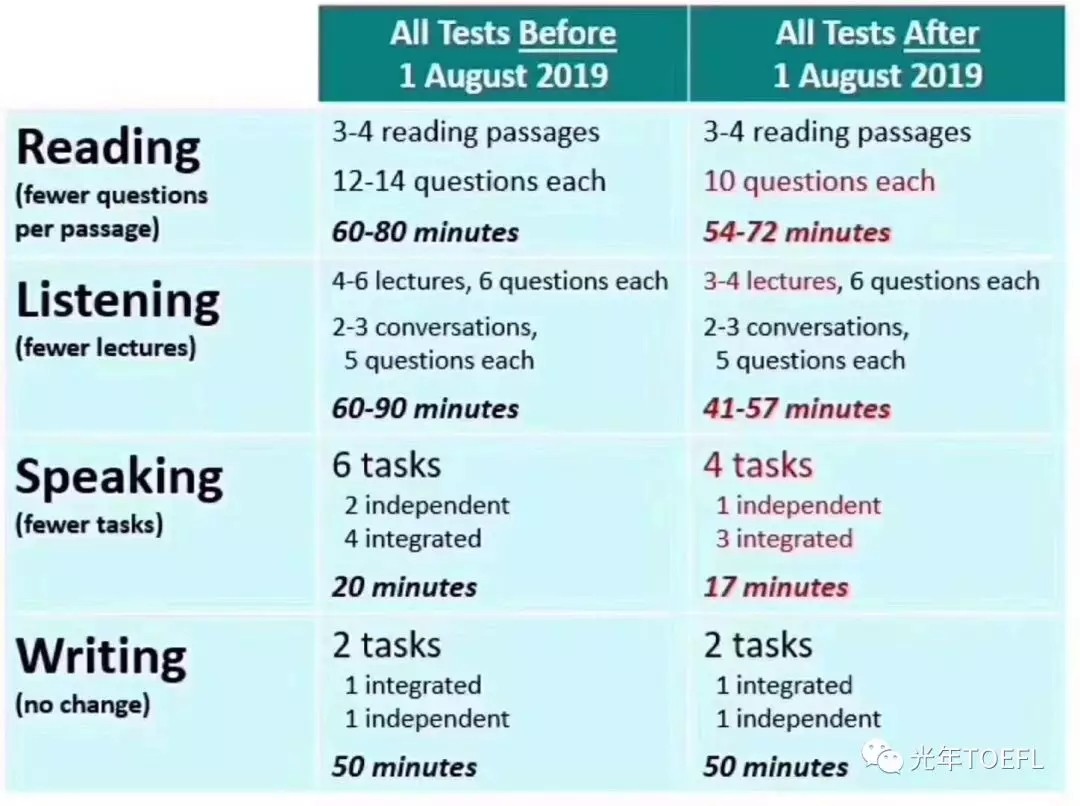雅思阅读要想上高分,一定要学会正确翻译文章中的长难句。今天小编给大家带来了雅思阅读长难句翻译练习之定语从句篇,希望能够帮助到大家,下面小编就和大家分享,来欣赏一下吧。
雅思阅读长难句翻译练习之定语从句篇
同学们都知道,定语从句可以分为限定性定语从句与非限定性定语从句。这种分类方式是根据中心词与修饰成分之间的关系密切程度决定的,那么我们在翻译和理解雅思阅读长难句的过程中,就可以根据定语从句的不同种类采取不同的翻译方法。
1. 非限定性定语从句的翻译方法
在非限定性定语从句中,中心词本身意义是明确的,修饰中心词的定语从句起补充说明的作用。所以在翻译时,将非限定性定语从句与之前的主句译为并列结构即可,即先翻译主句,再翻译非限定性定语从句。
例:This all amounts to heightened activity and noise levels, which have the potential to be particularly serious for children experiencing auditory function deficit. (J9T2P1P2)
讲解:
由于have是复数形式,所以which指代前文的heightened activity and noise levels。
可译为:这一切增加了活动量与噪音级别,这对患有听觉功能障碍的孩子有潜在的严重影响。
但是‘这’在中文中指代抽象,所以虽然句子成分分析准确,但是仍然不能理解句子和含义。修改如下:
这一切增加了活动量与噪音级别,增加了的活动量和噪音量对患有听觉功能障碍的孩子有潜在的严重影响。
2. 较短的限定性定语从句
在多数限定性定语从句中,中心词本身的意义不够明确的,需要定语从句修饰后才能确定准确含义。因此在翻译一般的限定性定语从句时,将定语从句像一般的定语一样翻译到中心词之前就可以了。注意,适用于这种翻译方法的定语从句长度一般较短。
例:In addition to the reptiles, birds, mammals and insects which we see all around us, other groups that have succeeded out of water include scorpions, snails, crustaceans such as woodlice and land crabs, millipedes and centipedes, spiders and various worms. (J9T1P3P1)
可译为:除了在我们身边看到的爬行类、鸟类、哺乳类和昆虫外,其他成功从海水中出来的种群还有蝎子,蜗牛,甲壳纲动物(木虱、陆生螃蟹、千足虫和蜈蚣)、蜘蛛和各种蠕虫。
3. 较长的限定性定语从句
那么对于不包括在上述范围内的较长的限定性定语从句,我们在翻译和理解的时候,可以像翻译非限定性定语从句那样,将其后置;如果像较短的限定性定语从句那样置于中心词之前翻译,可能会因为修饰成分过长打断翻译思路,影响对句子的整体理解。
例:Quite apart from the impracticality of sending a reply over such large distances at short notice, it raises a host of ethical questions that would have to be addressed by the global community before any reply could be sent. (J9T1P2P5)
可译为:除了立刻进行如此长距离的答复不可行之外,人们还提出了一系列道德问题,这些问题将必须等国际社会达成共识来解决。
以上就是今天雅思学科频道为大家带来的有关雅思阅读中定语从句的翻译方法,相信下次同学们再遇到这种长难句的时候都能翻译地很通畅。以后还会为大家带来其它语法知识的讲解,今天先到这儿,下期见!祝各位都能考出好成绩噢~
雅思阅读机经真题解析-Bestcome Considerate Computing
A
“Your battery is now fully charged”, Announced the laptop computer to its owner, Donald A Norman, with enthusiasm-perhaps even a hint of pride?---in its synthetic voice. To be sure, distractions and multitasking are hardly new to the human condition. “A complicated life, continually interrupted by computing requests for attention, is as old as procreation,” laughs Ted Selker of the Massachusetts Institute of Technology Media Lab. But increasingly, it is not just our kids pulling us three ways at once; it is also a relentless barrage of e-mail, alerts, alarms, calls, instant messages and automated notifications, none of them coordinated and all of them oblivious to whether we are busy—or even present. “It’s ridiculous that my own computer can’t figure out whether I’m in front of it, but a public toilet can,” exclaims Roel Vertegaal of Queen’s University in Ontario.
B
Humanity has connected itself through roughly three billion networked telephones, computers traffic lights—even refrigerators and picture frame—because these things make life more convenient and keep us available to those we care about. So although we could simply turn off the phones, close the e-mail program, and shut the office door when it is time for meeting or strench of concentrated work, we usually don’t. We just endure the consequences.
C
Numerous studies have shown that when people are unexpectedly interrupted, they not only work less efficiently but also make more mistakes. “It seems to add cumulatively to a feeling of frustration,” Picard reports, and that stress response makes it hard to regain focus. It isn’t merely a matter of productivity and the pace of life. For pilots, drivers, soldiers and doctors, errors of inattention can be downright dangerous. “If we could just give our computers and phones some understanding of the limits of human attention and memory, it would make them seem a lot more thoughtful and courteous,” says Eric Horvitz of Microsoft Research. Horvitz, Vertegaal, Selker and Picard are Eric Horvitz among a small but growing number of researchers trying to teach computers, phones, cars and other gadgets to behave less like egocentric oafs and more like considerate colleagues.
D
“Attentive” computing systems have begun appearing in newer Volvos and IBM has introduced Websphere communications software with a basic busyness sense. Microsoft has been running extensive in-house tests of a much more sophisticated system since 2003. Within a few year, companies may be able to offer every office worker a software version of the personal receptionist that only corner-suite executives enjoy today. But if such an offer should land in your inbox, be sure to read the print before you sign. An attentive system, by definition, is one that is always watching. That considerate computer may come to know more about your work habits than you do.
E
Most people aren’t as busy as they think they are, which is why we can usually tolerate interruptions from our inconsiderate electronic paraphernalia. James with Jennifer Lai of IBM Research to study 10 managers, researchers and interns at work. They Videotaped the subjects and periodically had them rate their “interruptibility. ” The amount of time the workers spent in leave-me-alone mode varied from person to person and day to day, ranging from 10 to 51pericent. On average, the subjects wanted to work without interruption about one third of the time. In studies of Microsoft employees, Horvitz has similarly found that they typically spend more than 65 percent of their day in a state of low attention.
F
Today’s phones and computers, which naively assume that the user is never too busy to take a call, read an email, or click “OK” on an alert box, thus are probably correct about two thirds of time. To be useful, then considerate systems will have to be more than 65 percent accurate in sending when their users are near their cognitive limits.
G
Bestcom/Enhanced Telephony, a Microsoft prototype based on Horvitz’s work, digs a litter deeper into each user’s computer to find clues about what they are up to. Microsoft launched an internal beta test of the system in mid-2003. By Last October, Horvitz says, about 3,800 people were using the system to field their incoming phone calls.
H
Horvitz himself is one of those testers, and while we talk in his office in Redmond, Wash., Bestcom silently handles one call after another. First it checks whether the caller is listed in his address book, the company directory, or its log of people he has called recently. Triangulating these sources, it tries to deduce their relationship. Family members, supervisors and people he called earlier today ring through. Others see a message on their computer that he is in meeting and won’t be available until 3 P.M. The system scans Horvitz’s and the caller’s calendar and offers to reschedule the call at a time that is open for both. Some callers choose that option, others leave voice mail. E-mail messages get a similar screening. When Horvitz is out of the office, Bestcom automatically offers to forward selected callers to his cellphone—unless his calendar and other evidence suggest that he is in a meeting.
I
Most large companies already use computerized phone systems and started calendar and contact management software, so tapping into those ‘sensors’ should be straightforward. Not all employees will like the idea of having a microphone on all the time in their office, however, nor will everyone want to expose their datebook to some program they do not ultimately control. Moreover, some managers might be tempted to equate a “state of low attention” with “goofing off” and punish those who seem insufficiently busy.
Question 14-19
Do the following statements agree with the information given in Reading Passage 2? In boxes 14-19 on your answer sheet, write
TURE if the statement is true
FALSE if the statement is false
NOT GIVEN if the information is not given in the passage
14. According to Ted Selker, human reproduction has been disturbed throughout history.
15. If people are interrupted by calls or e-mails, they usually put up with it instead of feeling sickness.
16. Microsoft is now investigating a software which is compatible with ordinary offices.
17. People usually have misperception about whether they are busy or not.
18. Experts in Carnegie Mellon University conducted a research observing all occupations of IBM.
19. Current phone and computer systems have shortcut keys for people receiving information immediately.
Question 20-26

Answer the questions in the diagram below.
Choose ONLY ONE WORD from the passage for each answer.
篇章说明:
体裁
论说文
题目
BESTCOM自动电话系统
结构
A段:描述生活中被外来事物不断打扰的困惑
B段:说明人们并没有关闭而是在忍受这些外部干扰
C段:说明意外干扰的危害
D段:介绍感应机器所需要具备的三种技能
E段:解释为什么人们能够忍受感受
F段:提出介绍Bestcom/Enhanced电话系统
G段:举例说明Bestcom的工作原理
H段:说明很多公司已经开始使用电脑话的电话系统

参考答案:
Version22305主题BESTCOM系统
14
NOT GIVEN
15
TURE
16
TURE
17
TURE
18
FALSE
19
NOT GIVEN
20
clues
21
relationship
22
message
23
reschedule
24
voice mail
25
cellphone
26
meeting






